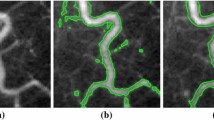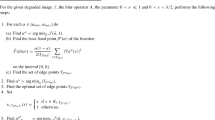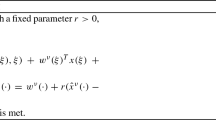Abstract
Image segmentation is to extract meaningful objects from a given image. For degraded images due to occlusions, obscurities or noises, the accuracy of the segmentation result can be severely affected. To alleviate this problem, prior information about the target object is usually introduced. In Chan et al. (J Math Imaging Vis 60(3):401–421, 2018), a topology-preserving registration-based segmentation model was proposed, which is restricted to segment 2D images only. In this paper, we propose a novel 3D topology-preserving registration-based segmentation model with the hyperelastic regularization, which can handle both 2D and 3D images. The existence of the solution of the proposed model is established. We also propose a converging iterative scheme to solve the proposed model. Numerical experiments have been carried out on the synthetic and real images, which demonstrate the effectiveness of our proposed model.















Similar content being viewed by others
References
Badshah, N., Chen, K.: Image selective segmentation under geometrical constraints using an active contour approach. Commun. Comput. Phys. 7(4), 759 (2010)
Balafar, M.A., Ramli, A.R., Saripan, M.I., Mashohor, S.: Review of brain MRI image segmentation methods. Artif. Intell. Rev. 33(3), 261–274 (2010)
Barrett, R., Berry, M.W., Chan, T.F., Demmel, J., Donato, J., Dongarra, J., Eijkhout, V., Pozo, R., Romine, C., Van der Vorst, H.: Templates for the solution of linear systems: building blocks for iterative methods, vol. 43. SIAM (1994)
Bers, L., et al.: Quasiconformal mappings, with applications to differential equations, function theory and topology. Bull. Am. Math. Soc. 83(6), 1083–1100 (1977)
Broit, C.: Optimal registration of deformed images. Ph.D. Thesis, University of Pennsylvania, USA (1981)
Brown, E.S., Chan, T.F., Bresson, X.: Completely convex formulation of the Chan–Vese image segmentation model. Int. J. Comput. Vis. 98(1), 103–121 (2012)
Burger, M., Modersitzki, J., Ruthotto, L.: A hyperelastic regularization energy for image registration. SIAM J. Sci. Comput. 35(1), B132–B148 (2013)
Caselles, V., Kimmel, R., Sapiro, G.: Geodesic active contours. Int. J. Comput. Vis. 22(1), 61–79 (1997)
Chan, H.L., Yan, S., Lui, L.M., Tai, X.C.: Topology-preserving image segmentation by Beltrami representation of shapes. J. Math. Imaging Vis. 60(3), 401–421 (2018)
Chan, T., Sandberg, B., Vese, L.: Active contours without edges for textured images. CAM report pp. 02–28 (2002)
Chan, T., Zhu, W.: Level set based shape prior segmentation. In: 2005 IEEE Computer Society Conference on Computer Vision and Pattern Recognition (CVPR’05), vol. 2, pp. 1164–1170. IEEE (2005)
Chan, T.F., Esedoglu, S., Nikolova, M.: Algorithms for finding global minimizers of image segmentation and denoising models. SIAM J. Appl. Math. 66(5), 1632–1648 (2006)
Chan, T.F., Sandberg, B.Y., Vese, L.A.: Active contours without edges for vector-valued images. J. Vis. Commun. Image Represent. 11(2), 130–141 (2000)
Chan, T.F., Shen, J.: Image Processing and Analysis: Variational, PDE, Wavelet, and Stochastic Methods. SIAM, Philadelphia (2005)
Chan, T.F., Vese, L.A.: Active contours without edges. IEEE Trans. Image Process. 10(2), 266–277 (2001)
Chen, K., Grapiglia, G.N., Yuan, J., Zhang, D.: Improved optimization methods for image registration problems. Numer. Algorithms 80(2), 305–336 (2019)
Christensen, G.E., Rabbitt, R.D., Miller, M.I., et al.: Deformable templates using large deformation kinematics. IEEE Trans. Image Process. 5(10), 1435–1447 (1996)
Chumchob, N., Chen, K., Brito, C.: A fourth-order variational image registration model and its fast multigrid algorithm. Multisc. Model. Simul. 9(1), 89–128 (2011)
Cremers, D., Sochen, N., Schnörr, C.: Towards recognition-based variational segmentation using shape priors and dynamic labeling. In: International Conference on Scale-Space Theories in Computer Vision, pp. 388–400. Springer (2003)
Diehl, M., Messerer, F.: Local convergence of generalized Gauss–Newton and sequential convex programming. In: 2019 IEEE 58th Conference on Decision and Control (CDC), pp. 3942–3947. IEEE (2019)
Droske, M., Rumpf, M.: A variational approach to nonrigid morphological image registration. SIAM J. Appl. Math. 64(2), 668–687 (2004)
Fischer, B., Modersitzki, J.: Fast diffusion registration. Contemp. Math. 313, 117–128 (2002)
Fischer, B., Modersitzki, J.: Curvature based image registration. J. Math. Imaging Vis. 18(1), 81–85 (2003)
Fischer, B., Modersitzki, J.: A unified approach to fast image registration and a new curvature based registration technique. Linear Algebra Appl. 380, 107–124 (2004)
Gardiner, F.P., Lakic, N.: Quasiconformal Teichmuller Theory, vol. 76. American Mathematical Society, Providence (2000)
Getreuer, P.: Chan–Vese segmentation. Image Process. On Line 2, 214–224 (2012)
Gout, C., Le Guyader, C., Vese, L.: Segmentation under geometrical conditions using geodesic active contours and interpolation using level set methods. Numer. algorithms 39(1–3), 155–173 (2005)
Haber, E., Modersitzki, J.: Numerical methods for volume preserving image registration. Inverse Prob. 20(5), 1621 (2004)
Haber, E., Modersitzki, J.: Intensity gradient based registration and fusion of multi-modal images. In: International Conference on Medical Image Computing and Computer-Assisted Intervention, pp. 726–733. Springer (2006)
Haber, E., Modersitzki, J.: A multilevel method for image registration. SIAM J. Sci. Comput. 27(5), 1594–1607 (2006)
Haber, E., Modersitzki, J.: Image registration with guaranteed displacement regularity. Int. J. Comput. Vis. 71(3), 361–372 (2007)
Haber, E., Modersitzki, J.: Intensity gradient based registration and fusion of multi-modal images. Methods Inf. Med. 46(03), 292–299 (2007)
Heimann, T., Meinzer, H.P.: Statistical shape models for 3d medical image segmentation: a review. Med. Image Anal. 13(4), 543–563 (2009)
Heldmann, S.: Multimodal registration of MR images with a novel least-squares distance measure. In: Medical Imaging 2010: Image Processing, vol. 7623, p. 76230A. International Society for Optics and Photonics (2010)
Ibrahim, M., Chen, K., Brito-Loeza, C.: A novel variational model for image registration using Gaussian curvature. Geom. Imaging Comput. 1(4), 417–446 (2014)
Kass, M., Witkin, A., Terzopoulos, D.: Snakes: active contour models. Int. J. Comput. Vis. 1(4), 321–331 (1988)
Li, B., Acton, S.T.: Active contour external force using vector field convolution for image segmentation. IEEE Trans. Image Process. 16(8), 2096–2106 (2007)
Lie, J., Lysaker, M., Tai, X.C.: A variant of the level set method and applications to image segmentation. Math. Comput. 75(255), 1155–1174 (2006)
Maes, F., Collignon, A., Vandermeulen, D., Marchal, G., Suetens, P.: Multimodality image registration by maximization of mutual information. IEEE Trans. Med. Imaging 16(2), 187–198 (1997)
Modersitzki, J.: Numerical Methods for Image Registration. Oxford University Press on Demand, Oxford (2004)
Modersitzki, J.: FAIR: Flexible Algorithms for Image Registration, vol. 6. SIAM, Providence (2009)
Mumford, D., Shah, J.: Optimal approximations by piecewise smooth functions and associated variational problems. Commun. Pure Appl. Math. 42(5), 577–685 (1989)
Nocedal, J., Wright, S.: Numerical Optimization. Springer, Berlin (2006)
Paige, C.C., Saunders, M.A.: Solution of sparse indefinite systems of linear equations. SIAM J. Numer. Anal. 12(4), 617–629 (1975)
Roberts, M., Chen, K., Irion, K.L.: A convex geodesic selective model for image segmentation. J. Math. Imaging and Vis. 61(4), 482–503 (2019)
Ruthotto, L.: Hyperelastic image registration: theory, numerical methods, and applications. Ph.D. Thesis, Verlag nicht ermittelbar (2012)
Thiruvenkadam, S.R., Chan, T.F., Hong, B.W.: Segmentation under occlusions using selective shape prior. In: International Conference on Scale Space and Variational Methods in Computer Vision, pp. 191–202. Springer (2007)
Zhang, D., Chen, K.: A novel diffeomorphic model for image registration and its algorithm. J. Math. Imaging Vis. 60(8), 1261–1283 (2018)
Zhang, J., Chen, K.: Variational image registration by a total fractional-order variation model. J. Comput. Phys. 293, 442–461 (2015)
Zhang, J., Chen, K., Gould, D.A.: A fast algorithm for automatic segmentation and extraction of a single object by active surfaces. Int. J. Comput. Math. 92(6), 1251–1274 (2015)
Zhang, J., Chen, K., Yu, B., Gould, D.A.: A local information based variational model for selective image segmentation. Inverse Probl. Imaging 8(1), 293 (2014)
Acknowledgements
We would like to thank Prof. Jan Modersitzki for his FAIR package [41] (https://github.com/C4IR/FAIR.m). We would also like to thank the anonymous reviewers for their valuable comments and suggestions to improve the quality of this manuscript. This work is partly supported by HKRGC GRF (Project ID: 2130656).
Author information
Authors and Affiliations
Corresponding author
Additional information
Publisher's Note
Springer Nature remains neutral with regard to jurisdictional claims in published maps and institutional affiliations.
Appendices
Computation of A in (27)
\(A = I_{3}\otimes (A_{1}^{T},A_{2}^{T},A_{3}^{T})^{T}\), \(A_{1} = I_{(n_{3}+1)}\otimes I_{(n_{2}+1)}\otimes \partial _{n_{1}}^{1,h_{1}}\), \(A_{2}=I_{(n_{3}+1)}\otimes \partial _{n_{2}}^{1,h_{2}}\otimes I_{(n_{1}+1)}\), \(A_{3}=\partial _{n_{3}}^{1,h_{3}}\otimes I_{(n_{2}+1)}\otimes I_{(n_{1}+1)}\) and
Here, \(\otimes \) indicates Kronecker product.
Computation of \(\varvec{s}(Y)\) and \(\varvec{v}(Y)\) in (28)
In each tetrahedron \(\varOmega ^{i,j,k,l}\), set \(\mathbf{L} ^{i,j,k,l}(\varvec{x})= (L_{1}^{i,j,k,l}(\varvec{x}),L_{2}^{i,j,k,l}(\varvec{x}),L_{3}^{i,j,k,l}(\varvec{x}))= (a^{i,j,k,l}_{1}x_{1}+a^{i,j,k,l}_{2}x_{2}+a^{i,j,k,l}_{3}x_{3}+b_{1}^{i,j,k,l}, a^{i,j,k,l}_{4}x_{1}+a^{i,j,k,l}_{5}x_{2}+a^{i,j,k,l}_{6}x_{3}+b_{2}^{i,j,k,l},a^{i,j,k,l}_{7}x_{1}\)\(+a^{i,j,k,l}_{8}x_{2}+a^{i,j,k,l}_{9}x_{3}+b_{3}^{i,j,k,l})\), which is the linear interpolation for \(\varvec{y}\) in the \(\varOmega ^{i,j,k,l}\). Note that
Then the following approximation can be built:
where
and
In order to write (49) into a compact form, we construct \(D_{l}, 1\le l\le 9\):
where \(M_{1}\), \(M_{2}\) and \(M_{3}\) are the discrete operators of \(\partial _{x_{1}}\), \(\partial _{x_{2}}\) and \(\partial _{x_{3}}\) respectively and how to construct them is shown in “Appendix C”. Then we define \(\varvec{s}(Y)\) and \(\varvec{v}(Y)\) as follows:
where \(\odot \) denotes the Hadamard product of two matrices. Furthermore, set the ith component of \(\varvec{s}(Y)\) as
Then we can see that \(\varvec{s}(Y)\) and \(\varvec{v}(Y)\) contain all approximated cofactors and determinants for all tetrahedrons.
Computation of \(M_{1}\), \(M_{2}\) and \(M_{3}\) in (52)
We first investigate the linear approximation \(L(x_{1},x_{2},x_{3}) = a_{1}x_{1}+a_{2}x_{2}+a_{3}x_{3}+b\) in the tetrahedron \(V_{3}V_{4}V_{5}V_{7}\) (Fig. 1). Denote these 4 vertices of this tetrahedron by \(V_{3} = \varvec{x}^{1,1,1}\), \(V_{4} = \varvec{x}^{2,2,2}\), \(V_{5} = \varvec{x}^{3,3,3}\) and \(V_{7} = \varvec{x}^{4,4,4}\). Set \(L(\varvec{x}^{1,1,1}) = y^{1,1,1}\), \(L(\varvec{x}^{2,2,2}) = y^{2,2,2}\), \(L(\varvec{x}^{3,3,3}) = y^{3,3,3}\) and \(L(\varvec{x}^{4,4,4}) = y^{4,4,4}\). Substituting \(V_{3},V_{4}\), \(V_{5}\) and \(V_{7}\) into L, we get
Then eliminating b, we obtain
Set
Then we have
where \(\det \) is the determinant of C and \(C_{ij}\) is the (i, j) cofactor of C. Since the domain \(\varOmega \) has been divided into N voxels, in order to find all \(a_{1}\) in the tetrahedron with the same position of each voxel, we can make it as follows:
where \(E_{l},l\in \{3,4,5,7\}\) is a matrix which extracts the corresponding positions of the vertices. Set \(G_{1} = \frac{1}{\det }(C_{11}(E_{3}-E_{7})+C_{21}(E_{4}-E_{7})+C_{31}(E_{5}-E_{7}))\). For other 5 tetrahedrons, we can also build \(G_{l}, l\in \{2,...,6\}\). Then we get
Similarly, we can obtain \(M_{2}\) and \(M_{3}\).
Rights and permissions
About this article
Cite this article
Zhang, D., Lui, L.M. Topology-Preserving 3D Image Segmentation Based on Hyperelastic Regularization. J Sci Comput 87, 74 (2021). https://doi.org/10.1007/s10915-021-01433-y
Received:
Revised:
Accepted:
Published:
DOI: https://doi.org/10.1007/s10915-021-01433-y




